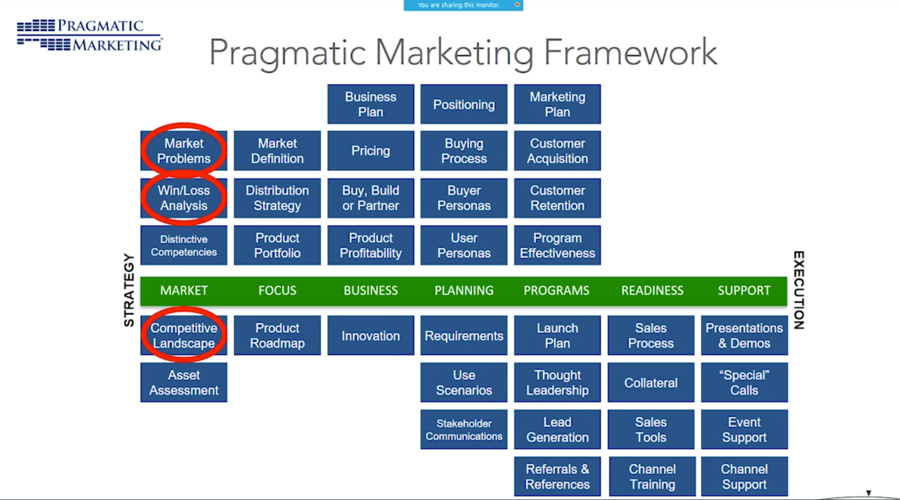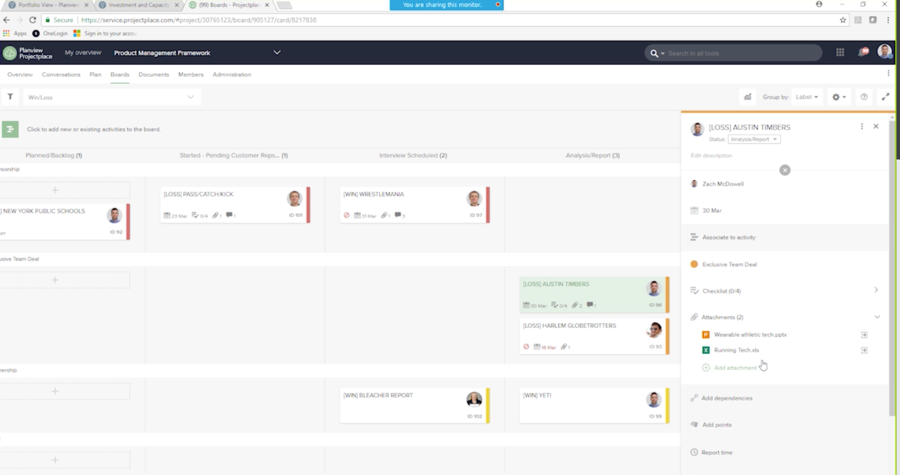
During this blog series, we’ve been examining how the Pragmatic Marketing Framework, together with Planview, helps organizations achieve a single source of truth throughout the product development lifecycle.
In part 1, we introduced the framework and described how it’s used to navigate through disparate voices across our businesses and organizations to establish our bearings and bring products to market faster and smarter.
In part II, we’re going to look at how the framework helps us address market problems by understanding the competitive landscape with honest, impartial win/loss analysis, and subsequent communications to the entire sales organization.
Looking at the framework below, you’ll see in the upper left that market problems are the cornerstone of the framework. Its position underscores the fact that almost everything in the framework starts from this box. That’s because you must understand the problems facing your customers and market before you can build an effective, value driven portfolio and solution. This first step is critical to getting everyone in your organization on the same page to address the defined problems.

Although the market problems box is seen as the foundation of the framework, win/loss analysis is arguably just as instrumental. Understanding why you win and why you lose cannot be discounted—this will help you drive features into your roadmap that will enable your sales teams to win. Then, we have the competitive box so we can quickly assess what our competitors are doing and how they stack up against us.
The framework helps us overcome the common challenges of addressing marketing problems across entire organizations, such as:
- Disseminating updated competitive information to sales teams in the field, which is especially difficult if your company is global
- Keeping information current and in a single location vs. point solutions and emails
- Tracking actionable outcomes from win/loss analysis or competitive trends
- Identifying and capturing market trends
We help to simplify these processes with Planview Projectplace, which combines online team collaboration tools with powerful project management capabilities. As part of the framework, ProjectPlace provides this single source of truth that all product managers need in their day-to-day.
It helps you capture market trends so you can be first to market and arm your sales team with competitive insights from win/loss reports and documents that can be easily found and accessed from anywhere.
When you have this level of visibility in a central location, it is easier to equip your sales teams with the information they need to succeed in the field. They can also access all of that information quickly and easily from their smart phones while they’re on the go, between customer and prospect sites. ProjectPlace also allows for real time updates to sensitive information, so everyone is always in the loop and nothing will fall through the cracks.
For example, looking at our board below for our fictitious sports apparel company, if we lost a deal to Nike, we can use ProjectPlace to schedule interviews and determine why we lost, allowing product managers to take those data points and ensure those types of losses don’t happen again.

We can document and post to a colleague, for example, that we lost to Nike because they have better ‘smart’ footwear. Now they know that we lost, they know why, and they have access to documentation that shows what we need to do to win next time.
I can also go to the conversation area to post about the issue with hashtags like #competitive and #marketproblem so others can locate and track that information fast with a quick search.
With Projectplace, if a sales person comes in contact with a competitor during a sales call, they can locate our competitive insights on their phone at the meeting and filter their search to find the information needed at that moment.
ProjectPlace meshes together the best capabilities of tools like SharePoint, Drop Box, and Slack in one location for easy access anywhere. It delivers insights needed to give global teams that competitive edge in less time and with lower costs.
In the last of this series, we’ll examine how the Pragmatic Marketing Framework, together with Planview, is used to improve the development of product roadmaps.





